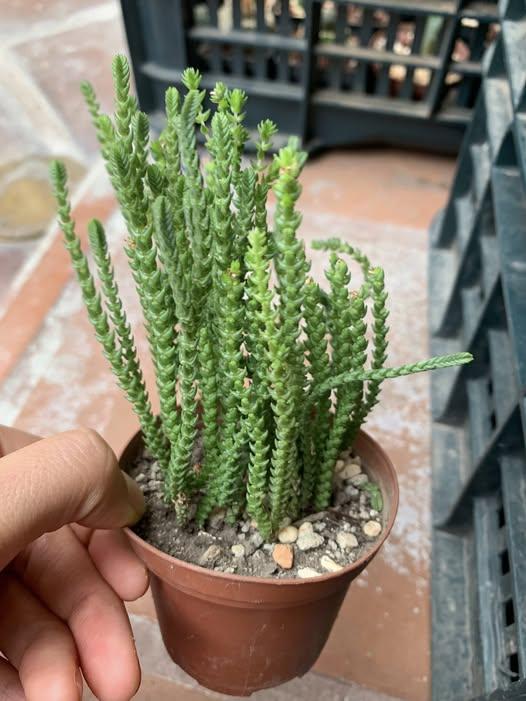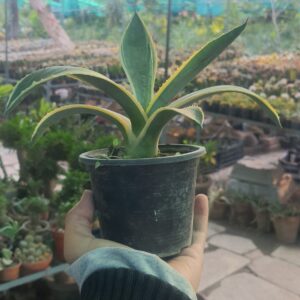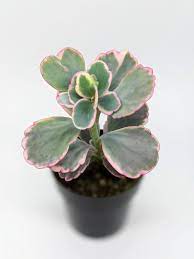🌿✨ Crassula muscosa — Watch Chain Plant
Crassula muscosa, commonly referred to as the Watch Chain Plant, Zipper Plant, or Princess Pine, is a unique and visually captivating succulent belonging to the Crassulaceae family. Native to South Africa and Namibia, it thrives in arid and semi-arid climates, forming dense mats of tiny, tightly packed, overlapping leaves along thin, branching stems. This gives the plant a texture similar to a braided chain or a zipper, hence its popular names.
This succulent is ideal for growers seeking a small, intricate, and fast-spreading plant, suitable for both indoor and outdoor decorative purposes.
🌿 Botanical Overview
Scientific Name: Crassula muscosa
Common Names: Watch Chain Plant, Zipper Plant, Princess Pine
Family: Crassulaceae
Native Range: South Africa, Namibia
Growth Habit: Mat-forming, trailing or upright shrublet
Size:
Height: 15–30 cm (6–12 inches)
Spread: Can trail several feet when mature
USDA Hardiness Zones: 9–11 (frost-sensitive)
🍃 Appearance
Leaves:
Tiny, scale-like leaves densely packed around the stems in a spiraled fashion
Bright green to light green in color, turning reddish or brownish under stress (sun exposure or drought)
Stems:
Thin, branching, sometimes woody at the base with age
Forms dense thickets or trailing strands
Flowers:
Tiny, yellowish-green, star-shaped flowers
Inconspicuous but can appear in spring to summer
Lightly fragrant but not particularly showy
☀️ Light Requirements
Indoors:
Prefers bright, indirect light
Can tolerate filtered morning sunlight
Place near a south or east-facing window
Low light may cause leggy, sparse growth
Outdoors:
Thrives in full sun to partial shade
In very hot climates, provide some afternoon shade to prevent leaf burn
Ample light ensures compact, dense foliage and vibrant color.
🌡️ Temperature & Humidity
Temperature:
Ideal range: 18–27°C (65–80°F)
Sensitive to frost: Protect from temperatures below 5°C (41°F)
Move indoors during winter in cooler regions
Humidity:
Prefers low to moderate humidity
Adapted to dry environments
Good air circulation helps prevent moisture-related issues like fungal infections.
💧 Watering Routine
Growing Season (Spring to Fall):
Water when the top 1–2 inches of soil are dry
Typically every 7–10 days in warm months
Allow soil to dry completely between watering
Winter Dormancy:
Reduce watering to once every 3–4 weeks
Keep soil just barely moist to prevent root rot
🚫 Avoid overwatering, as the roots and stems are prone to rot in soggy conditions.
🌱 Soil Requirements
Type:
Needs well-draining soil
Ideal mix:
50% cactus/succulent soil
25% perlite or pumice
25% coarse sand
pH: Slightly acidic to neutral (6.0–7.0)
Proper drainage is essential for maintaining healthy roots.
🌾 Fertilizing
Growing Season:
Fertilize once a month with a diluted succulent fertilizer (half strength)
A balanced or low-nitrogen formula like 5-10-10 is ideal
Winter:
Do not fertilize during dormancy
✂️ Maintenance and Pruning
Pruning:
Prune regularly to maintain shape and prevent legginess
Trimming also encourages bushier growth
Remove any dead, damaged, or excessively long stems
Pest Control:
Susceptible to:
Mealybugs
Aphids
Spider mites
Treat with neem oil, insecticidal soap, or alcohol swabs
🌿 Propagation
Stem Cuttings:
Take a 4-6 inch cutting from a healthy stem.
Let the cutting callous for 1–2 days.
Plant in well-draining soil.
Water lightly after a few days to encourage rooting.
Division:
Can also be propagated by separating dense clumps and replanting them.
Both methods are easy and reliable, often resulting in rapid establishment.
🛡️ Common Issues
Overwatering: Causes root and stem rot
Lack of Light: Results in leggy, sparse growth
Pests: Mealybugs, aphids, and mites in dry or dusty conditions
Sunburn: If abruptly moved to intense direct sun
Consistent care with adequate light, controlled watering, and occasional pruning prevents most problems.
🎍 Decorative Use
Best For:
Indoor potted plants
Hanging baskets (trailing effect)
Terrariums
Rock and succulent gardens
Ground cover in warm, dry climates
Its intricate texture makes it a perfect contrast plant in succulent arrangements or as a trailing feature in containers.
✅ Conclusion
Crassula muscosa is a unique, low-maintenance succulent that’s perfect for adding texture and variety to both indoor and outdoor spaces. With its watch chain-like foliage, moderate watering needs, and simple propagation, it’s a rewarding plant for beginners and enthusiasts alike. Provide it with bright light, well-draining soil, and minimal water, and it will thrive with minimal effort.





Reviews
There are no reviews yet.